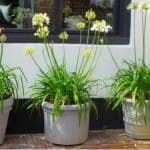Last updated on March 22nd, 2022
Our site is reader supported, this means we may earn a small commission from Amazon and other affiliates when you buy through links on our site.
Chrysanthemums come in 50 different species, all native to East Asia, and they make excellent flowers no matter where you plant them. In fact, Chrysanthemums are the second most popular flower after roses. You can find a variety of shapes, sizes, and designs for the flowers, which is what makes them so prominent.
One of the strongest varieties, popular because of its frost resistance is that of the Chrysanthemum grandiflorum, however, if you are planning on growing Chrysanthemums in pots, you want to choose a compact smaller variety that doesn’t get too tall.
Growing Chrysanthemums in pots
Perfect for autumn colour
Chrysanthemums make the perfect addition to any balcony, porch, terrace, or patio and are perfect for growing on containers. When you grow them in pots you will typically grow them as annuals for a little autumn colour. If you’re really into gardening you may choose to take cuttings to grow on too.
Be prepared though, these particular flowers are considered short-day plants. That means that they bloom most effectively when the days start getting shorter and bring with them a change to the amount of light received. Most Chrysanthemums will start to bloom more heavily in the autumn, which is why you often see smaller growing varieties sold as autumn bedding and larger plants to use specimen plants that are perfect for pots.
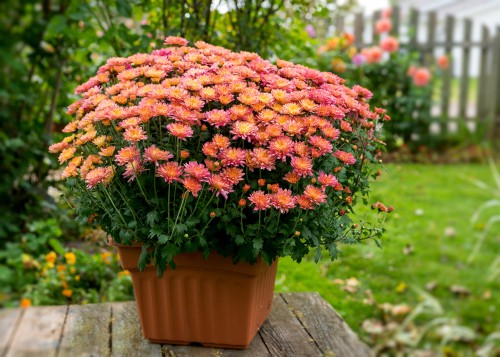
This is why so many people combine them with other flowers in pots so that as the other flowers reach their peak in the summer, Chrysanthemums are there to pick up the slack. If you are planting an autumn or winter planter they are going to go well with cyclamen, ornamental cabbage, winter pansies and violas.
As a newcomer to gardening, Chrysanthemums are a wonderful place to start because all you need to provide is the right soil conditions. They require very little maintenance, with the exception of a little deadheading to keep them flowering for longer.
Picking the Container
With Chrysanthemums, you don’t have to be as finicky about the container you choose. The most important thing is the soil in which the plants are grown. So you can pick a smaller sized pot that you can either affix directly to your balcony if you want it to sit along the railing, or set on a small table next to your outdoor seating area, whatever works for you. The material is also up to you. Some pot material can absorb water more effectively but again, Chrysanthemums are very low-maintenance so you don’t really have to worry too much about this.
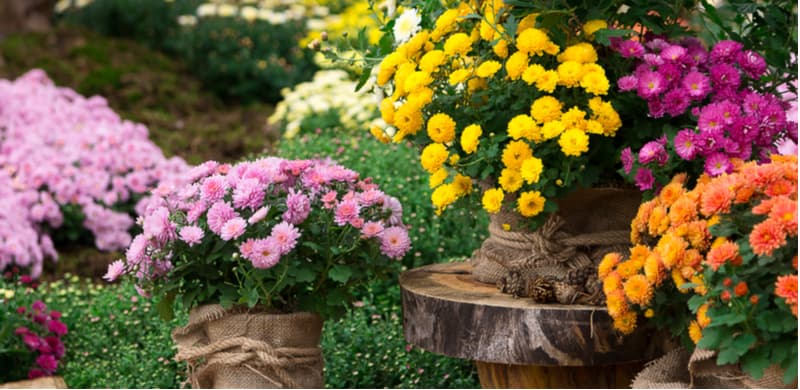
Planting your Chrysanthemums in Containers
Choosing the right compost
When you are ready to plant your Chrysanthemums, you want to add potting compost such as John Innes compost and mix some grit in to improve the drainage, failing this they also usually grow well in multipurpose compost too.
Carefully remove the Chrysanthemums from the container in which they were purchased. More often than not when you purchase plants from a nursery they come in a very thin plastic container or trays and you want to hold the base of the flower carefully without breaking any of the leaves and turn it on its side so that you can examine the bottom of the container. The reason you want to do this is simply to check on the roots.
If the Chrysanthemum is rootbound, which is sometimes the case with larger plants in full bud, you will see the roots all struggling out the drainage holes. If this is the case, you have to be slightly more careful when you take it out of the pot and transplant them so that you don’t damage the roots.
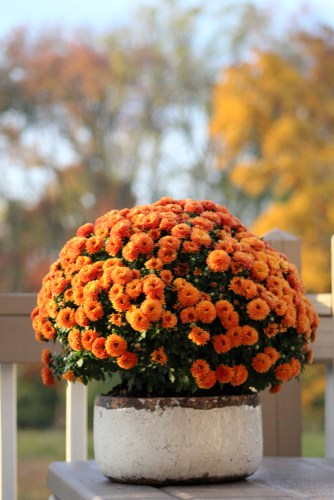
Remove it from the pot and place it into your container at the same depth it was grown previously. Backfill the hole with your mixture of potting soil and grit or multipurpose compost and then gently press it down around the base of the plant to make sure that there are no gaps.
After you have planted your Chrysanthemum water it generously to help the soil settle. And continue watering generously for the first two weeks after planting so that your Chrysanthemums have an opportunity to truly establish themselves, but be careful not to overwater.
Where to position your potted Chrysanthemums
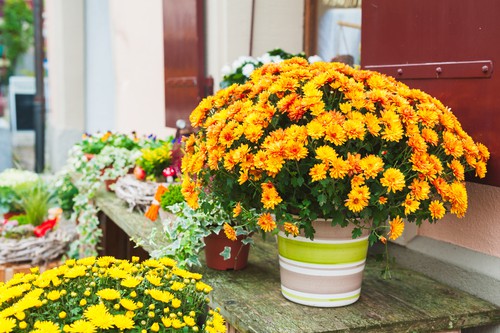
Position them in a sunny position where they get plenty of light
Once everything is planted it’s time to place your pots indoors or outdoors. If you are growing them outdoors you want a location that is bright and sunny. If you are growing them indoors you need a spot where the Chrysanthemums will receive at least 5 hours of direct sunlight every single day.
You want to also make sure there’s enough room for proper air circulation, so if you have multiple containers don’t place them very tightly next to one another or the flowering Chrysanthemums might end up blocking one another.
Feeding and Watering
As you continue to care for your plants, it’s recommended that you water regularly. They have a very shallow root system so you want to make sure the soil is always moist but never waterlogged.
Feed with a high nitrogen feed early in the season and swap to a high in potash feed when in bud and flowering
In terms of feeding, you can add some fertiliser before the flower buds start to form to help with the roots. At the start of the growing season, you can apply a slow-release fertiliser (which is high nitrogen fertiliser) to promote new growth and then when you notice buds forming it’s time to switch to a high potash feed, such as tomato feed every 2 weeks to promote more flowers.
Pests and Diseases
If you are growing your plants outside keep your eyes peeled for things like aphids and caterpillars. These pests can be simply washed away, removed by hand or sprayed with a pesticide if needed. Inside and outside you need to keep your eyes peeled for powdery mildew or grey mould on your plant, indicative of over-watering or improper air circulation. If you start to see these problems, remove the affected areas of the plant and start integrating better air circulation or less water.
Deadheading Chrysanthemums to promote more flowers
Much the same as other plants, you can encourage more blooms by removing the faded flowers with a process called deadheading. Once you see the Chrysanthemum blooms have reached their maturity and they’re now starting to fade and turn brown, clip them off.
Your plant only has a finite amount of energy and if the spent blooms are allowed to remain in place your plant will continue sending energy to those blooms to initiate the development of seeds later. If you remove the spent blooms, your plant will start sending its energy into new flowers. If your plant is looking like its nearly finished flowering it can be worth cutting them back fairly hard because they often flower again for a second time.
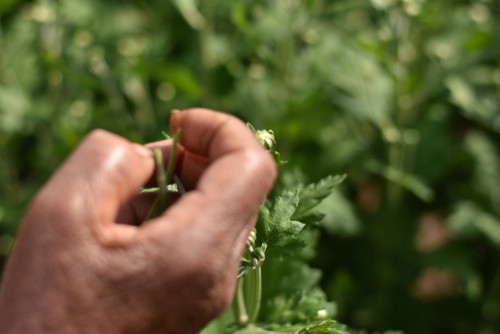
You can also prune any discoloured leaves or dead branches as soon as you notice them. This will keep your plant healthy and aesthetically appealing.
Overall, maintaining your Chrysanthemums in pots is very simple, whether you have them indoors or outdoors. You can enjoy beautiful flowers all throughout the autumn to help you transition from the rich colours of summer into the more vibrant displays of autumn.


